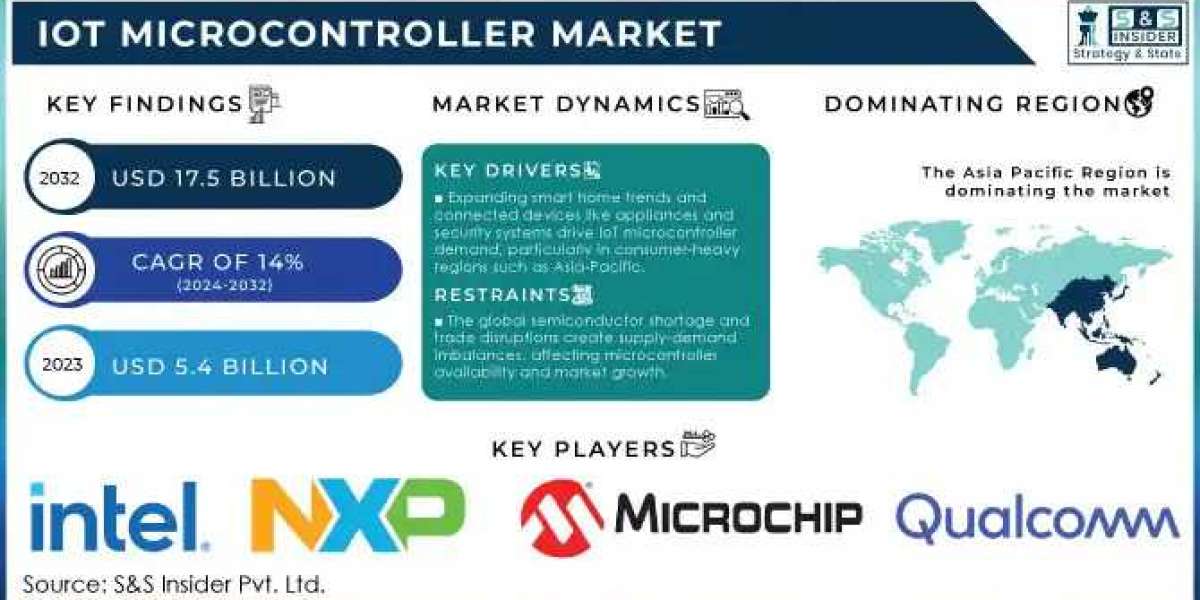IoT Microcontroller 2024
The Internet of Things (IoT) is revolutionizing industries by enabling devices to connect, communicate, and exchange data in real time. At the core of these intelligent devices lies the IoT microcontroller, a crucial component that controls the functioning of embedded systems and devices. As the demand for IoT devices surges, the role of IoT microcontrollers becomes increasingly significant in driving innovation across various sectors. The IoT Microcontroller Market Growth reflects this rising demand, with the IoT Microcontroller Market valued at USD 5.4 Billion in 2023 and is expected to reach USD 17.5 Billion by 2032, growing at a CAGR of 14% over the forecast period 2024-2032.
Understanding IoT Microcontrollers
An IoT microcontroller is essentially a small, low-power computing device embedded within IoT devices to manage their operations. These microcontrollers process the input from sensors, make decisions based on programmed algorithms, and enable communication with other devices or cloud platforms. Typically built with a central processing unit (CPU), memory, and input/output peripherals, IoT microcontrollers are designed to meet the specific requirements of IoT applications, such as energy efficiency, low cost, and real-time data processing.
The primary function of these microcontrollers is to manage the data collected from sensors and actuators and enable seamless communication over networks. They ensure that connected devices can execute tasks, analyze data, and communicate with other devices or cloud services with minimal latency. From home automation systems and wearables to industrial monitoring solutions, IoT microcontrollers are a vital part of the backbone of the modern digital ecosystem.
Key Features and Benefits
IoT microcontrollers are designed with specific attributes that make them ideal for IoT applications. One of the most critical features is their low power consumption, enabling devices to run on battery power for extended periods without frequent recharging. This feature is particularly important in applications like smart sensors, remote monitoring devices, and wearables, where energy efficiency is essential.
Another important characteristic is their compact size. Due to the need for miniaturized IoT devices, microcontrollers are built to occupy minimal space, making them perfect for integration into small form factor devices. Additionally, these microcontrollers are optimized for real-time data processing, allowing them to handle tasks such as sensor data acquisition, processing, and communication with low latency, which is crucial for time-sensitive applications.
Moreover, IoT microcontrollers are often designed to support multiple communication protocols, such as Wi-Fi, Bluetooth, Zigbee, and cellular networks, enabling devices to connect and communicate seamlessly in different environments. This flexibility is key in ensuring that IoT systems can work across various platforms and provide the necessary interoperability between devices.
The Role of IoT Microcontrollers in Different Industries
The growing adoption of IoT across various industries is driving the demand for more advanced and specialized microcontrollers. In smart homes, IoT microcontrollers power devices like thermostats, security cameras, and lighting systems, allowing homeowners to monitor and control their environment remotely. Healthcare is another sector where these microcontrollers play a critical role, powering wearable health devices, remote patient monitoring systems, and medical equipment that require constant connectivity and data exchange.
In the industrial sector, IoT microcontrollers are embedded in equipment used for predictive maintenance, asset tracking, and real-time monitoring of operations. These microcontrollers enable smart factories to automate processes, improve efficiency, and reduce downtime by providing actionable insights derived from collected data. Additionally, in the automotive industry, IoT microcontrollers are becoming integral to vehicle telematics, autonomous driving systems, and connected car technologies.
Advancements in IoT Microcontroller Technology
As the IoT ecosystem continues to grow, so does the demand for more powerful and capable microcontrollers. Technological advancements in IoT microcontroller design are focused on improving power efficiency, processing speed, and connectivity options. The development of multi-core microcontrollers allows for better processing of complex tasks, while integrated security features help protect data and prevent cyberattacks in an increasingly connected world.
The rise of 5G technology is also expected to enhance the capabilities of IoT microcontrollers, offering faster and more reliable communication for devices. With the ability to process higher volumes of data and support greater device interconnectivity, IoT microcontrollers will become even more critical in powering the next generation of IoT applications.
Conclusion
IoT microcontrollers are the building blocks of the interconnected world, enabling a wide range of devices to communicate, process data, and function autonomously. Their ability to support low power consumption, real-time data processing, and versatile communication protocols makes them indispensable for a multitude of industries. The IoT Microcontroller Market Growth signals a promising future as the demand for IoT devices continues to rise. With technological advancements and an expanding application range, IoT microcontrollers are poised to become even more integral to the digital transformation of industries worldwide. As businesses and consumers alike embrace the potential of IoT, microcontrollers will remain at the heart of this technological revolution.
Contact Us:
Akash Anand – Head of Business Development Strategy
info@snsinsider.com
Phone: +1-415-230-0044 (US) | +91-7798602273 (IND)
About Us
SS Insider is one of the leading market research and consulting agencies that dominates the market research industry globally. Our company's aim is to give clients the knowledge they require in order to function in changing circumstances. In order to give you current, accurate market data, consumer insights, and opinions so that you can make decisions with confidence, we employ a variety of techniques, including surveys, video talks, and focus groups around the world.
Read Our Other Reports:
Applicant Tracking System Market Share














